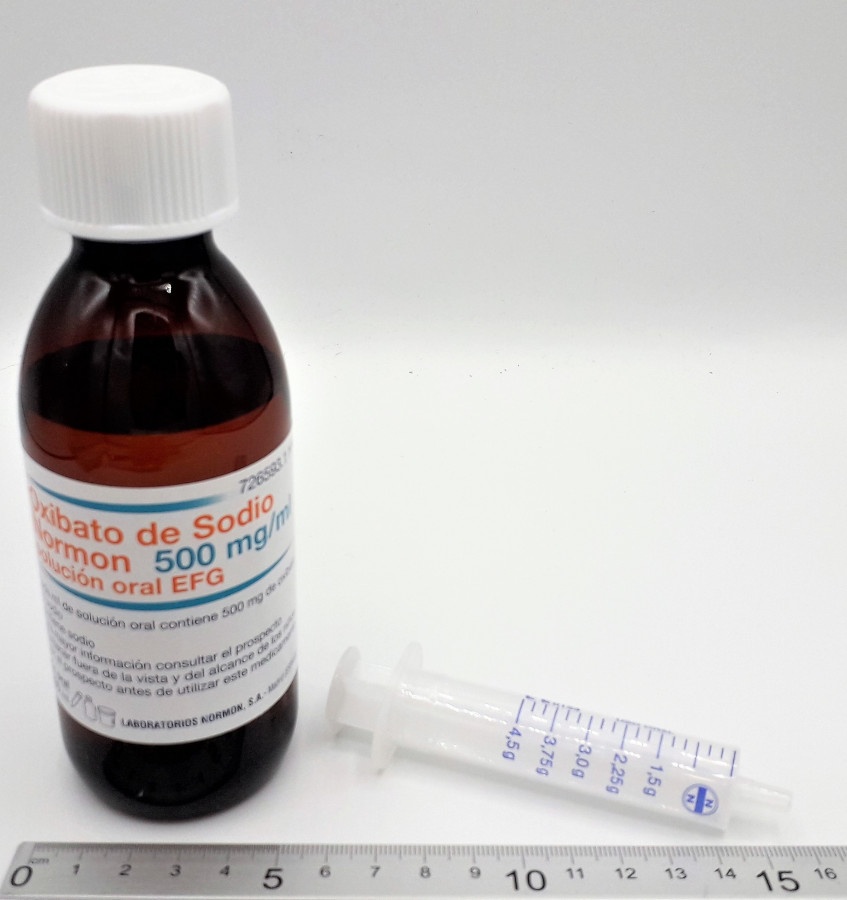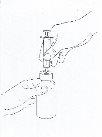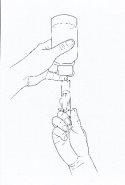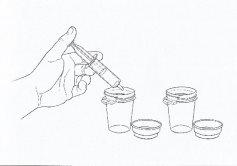

ОКСИБАТО СОДИЯ САЛА 500 мг/мл ОРАЛЬНЫЙ РАСТВОР

Спросите врача о рецепте на ОКСИБАТО СОДИЯ САЛА 500 мг/мл ОРАЛЬНЫЙ РАСТВОР

Инструкция по применению ОКСИБАТО СОДИЯ САЛА 500 мг/мл ОРАЛЬНЫЙ РАСТВОР
Введение
Прошпект: Информация для пользователя
Оксибат натрия Сала 500 мг/мл раствор для приема внутрь ЭФГ
Прочитайте весь прошпект внимательно перед началом приема этого лекарства, поскольку он содержит важную информацию для вас.
- Сохраните этот прошпект, поскольку вам может потребоваться прочитать его снова.
- Если у вас есть какие-либо вопросы, проконсультируйтесь с вашим врачом или фармацевтом.
- Это лекарство было назначено только вам, и не передавайте его другим людям, даже если они имеют те же симптомы, что и вы, поскольку оно может нанести им вред.
- Если вы испытываете побочные эффекты, проконсультируйтесь с вашим врачом или фармацевтом, даже если это побочные эффекты, которые не указаны в этом прошпекте. См. раздел 4.
Содержание прошпекта:
- Что такое Оксибат натрия Сала и для чего он используется
- Что вам нужно знать перед началом приема Оксибата натрия Сала
- Как принимать Оксибат натрия Сала
- Возможные побочные эффекты
- Хранение Оксибата натрия Сала
- Содержание упаковки и дополнительная информация
л
1. Что такое Оксибат натрия Сала и для чего он используется
Оксибат натрия Сала содержит активное вещество оксибат натрия. Оксибат натрия Сала действует, укрепляя ночной сон, хотя его точный механизм действия не известен.
Оксибат натрия Сала используется для лечения нарколепсии с катаплексией у взрослых, подростков и детей от 7 лет.
Нарколепсия - это расстройство сна, которое может включать в себя приступы сна в течение часов, когда вы обычно бодрствуете, а также катаплексию, паралич сна, галлюцинации и бессонницу. Катаплексия - это внезапное появление слабости или мышечной паралича без потери сознания в ответ на внезапную эмоциональную реакцию, такую как гнев, страх, радость, смех или удивление.
2. Что вам нужно знать перед началом приема Оксибата натрия Сала
Не принимайте Оксибат натрия Сала
- если вы аллергичны к оксибату натрия или любому другому компоненту этого лекарства (указанному в разделе 6);
- если у вас есть дефицит семиальдегидного сукцината дегидрогеназы (редкое метаболическое расстройство);
- если вы страдаете тяжелой депрессией;
- если вы получаете лечение опиоидными или барбитуратными препаратами.
Предостережения и меры предосторожности
Проконсультируйтесь с вашим врачом или фармацевтом перед началом приема Оксибата натрия Сала.
- если у вас есть проблемы с дыханием или легкими (и особенно если вы страдаете ожирением), поскольку Оксибат натрия Сала может вызывать трудности с дыханием;
- если у вас есть или было депрессия, суицидальные мысли, тревога, психоз (психическое расстройство, которое может включать в себя галлюцинации, бессвязную речь или дезорганизованное и агрессивное поведение) или биполярное расстройство;
- если у вас есть сердечная недостаточность, гипертония (высокое кровяное давление), проблемы с печенью или почками, вам может потребоваться коррекция дозы;
- если вы ранее употребляли наркотики или злоупотребляли лекарствами;
- если у вас есть эпилепсия, поскольку не рекомендуется использовать Оксибат натрия Сала при этом заболевании;
- если у вас есть порфирия (редкое метаболическое расстройство).
Если у вас есть какие-либо из этих проблем, сообщите об этом вашему врачу перед приемом Оксибата натрия Сала.
Если во время приема Оксибата натрия Сала вы испытываете ночную потерю мочи и недержание (как мочи, так и кала), путаницу, галлюцинации, эпизоды лунатизма или аномальное мышление, немедленно сообщите об этом вашему врачу. Хотя эти эффекты редки, если они появляются, они обычно легкие или умеренные.
У пожилых людей врач будет внимательно следить за их состоянием, чтобы проверить, вызывает ли это лекарство желаемые эффекты.
Оксибат натрия Сала имеет хорошо известный потенциал для злоупотребления. Были случаи зависимости после незаконного использования оксибата натрия.
Ваш врач спросит, употребляли ли вы какие-либо наркотики до начала приема этого лекарства и во время приема.
Дети и подростки
Оксибат натрия Сала могут принимать подростки и дети от 7 лет, если они весят более 15 кг.
Оксибат натрия Сала не могут принимать дети младше 7 лет или весящие менее 15 кг.
Если вы ребенок или подросток, ваш врач будет регулярно контролировать ваш вес.
Пока врач корректирует дозу, что может занять несколько недель, родители/опекуны должны внимательно следить за дыханием ребенка в течение первых 2 часов после приема оксибата натрия, чтобы оценить, есть ли какие-либо аномалии в дыхании; например, прерывание дыхания на короткие периоды во время сна, храп и синий цвет губ и лица. Если обнаружены аномалии в дыхании, необходимо обратиться за медицинской помощью, и врач должен быть проинформирован как можно скорее. Если обнаружена аномалия после первой дозы, вторая доза не должна быть назначена. Если не обнаружено никаких аномалий, вторая доза может быть назначена. Вторая доза не должна быть назначена раньше, чем через 2,5 часа, и не позже, чем через 4 часа после приема первой дозы.
Если вы испытывали неприятные ощущения, особенно если вы чувствуете себя очень грустно или потеряли интерес к жизни, важно сообщить об этом вашему врачу или опекуну.
Использование Оксибата натрия Сала с другими лекарствами
Сообщите вашему врачу или фармацевту, если вы используете, недавно использовали или можете использовать любое другое лекарство.
В частности, Оксибат натрия Сала не должен использоваться вместе с лекарствами, которые вызывают сон и лекарствами, которые снижают активность центральной нервной системы (центральная нервная система - это часть тела, состоящая из мозга и спинного мозга):
Также необходимо сообщить вашему врачу или фармацевту, если вы используете какие-либо из следующих типов лекарств:
- лекарства, которые увеличивают активность центральной нервной системы
- антидепрессанты
- лекарства, которые могут метаболизироваться организмом подобным образом (например, валпроат, фенитоин или этосуксимид, используемые для лечения эпилептических приступов)
- топирамат (используемый для лечения эпилепсии)
Если вы принимаете валпроат, ваша суточная доза Оксибата натрия Сала должна быть скорректирована (см. раздел 3), поскольку может возникнуть взаимодействие.
Прием Оксибата натрия Сала с пищей, напитками и алкоголем
Не следует употреблять алкоголь во время приема этого лекарства, поскольку его эффекты могут быть усилены.
Беременность и лактация
Если вы беременны или кормите грудью, считаете, что можете быть беременной или планируете стать беременной, проконсультируйтесь с вашим врачом или фармацевтом перед использованием этого лекарства. Было очень мало случаев, когда женщины принимали оксибат натрия во время беременности, и некоторые из них испытывали спонтанные аборты. Неизвестен риск приема Оксибата натрия Сала во время беременности, поэтому не рекомендуется его использование у беременных женщин или женщин, которые пытаются стать беременными.
Пациентки, принимающие Оксибат натрия Сала, должны прекратить грудное вскармливание, поскольку Оксибат натрия Сала проникает в грудное молоко.
Были обнаружены изменения сна у младенцев матерей, подвергшихся воздействию.
Вождение и использование машин
Оксибат натрия Сала может повлиять на вас, если вы водите или используете машины. Не водите, не используйте тяжелую технику, не выполняйте никаких действий, которые могут быть опасными или требовать умственной бдительности, в течение как минимум 6 часов после приема Оксибата натрия Сала. Когда вы начнете принимать Оксибат натрия Сала впервые и до тех пор, пока не будете знать, вызывает ли он сонливость на следующий день, будьте особенно осторожны, когда водите, работаете с тяжелой техникой или выполняете любые другие действия, которые могут быть опасными или требовать полной умственной бдительности.
У детей врач предупредит врачей, родителей или опекунов, что время ожидания перед выполнением действий, требующих умственной бдительности, координации движений или действий, которые могут представлять физический риск, может быть более 6 часов, в зависимости от индивидуальной чувствительности.
Оксибат натрия Сала содержит натрий
Это лекарство содержит 182,24 мг натрия (основного компонента поваренной соли) в каждом грамме. Это эквивалентно 9,11% от максимально допустимой суточной нормы потребления натрия для взрослого.
Проконсультируйтесь с вашим врачом или фармацевтом, если вам необходимо принимать 2 г оксибата натрия или более в день в течение длительного периода, особенно если вам рекомендована диета с низким содержанием соли (натрия).
3. Как принимать Оксибат натрия Сала
Следуйте точно инструкциям по приему этого лекарства, указанным вашим врачом или фармацевтом. В случае сомнений проконсультируйтесь с вашим врачом или фармацевтом.
Важно использовать только шприц, включенный в упаковку, во время приготовления доз Оксибата натрия Сала.
Взрослые: прием Оксибата натрия Сала только
- Для взрослых рекомендуемая начальная доза составляет 4,5 г в день, разделенная на две отдельные дозы по 2,25 г.
- Ваш врач может постепенно увеличить вашу дозу до максимальной - 9 г в день, разделенной на две отдельные дозы по 4,5 г.
- Принимайте Оксибат натрия Сала перорально дважды каждую ночь:
- Принимайте первую дозу, когда ложитесь спать, и вторую дозу через 2,5-4 часа позже. Вам может потребоваться будильник, чтобы проснуться и принять вторую дозу.
- Пища снижает количество Оксибата натрия Сала, которое абсорбируется вашим организмом. Поэтому лучше принимать Оксибат натрия Сала всегда в одно и то же время, через 2-3 часа после еды.
- Подготовьте обе дозы перед сном.
- Принимайте дозы в течение 24 часов после их приготовления.
Подростки и дети от 7 лет, весящие 15 кг или более: прием Оксибата натрия Сала только
Для детей от 7 лет, весящих 15 кг или более, врач рассчитает подходящую дозу на основе веса тела.
Врач рассчитает для вас подходящую дозу. Не превышайте дозу, которая была назначена вам.
Взрослые: прием Оксибата натрия Сала с валпроатом
Если вы принимаете валпроат вместе с Оксибатом натрия Сала, ваш врач скорректирует дозу Оксибата натрия Сала.
- Для взрослых рекомендуемая начальная доза Оксибата натрия Сала при использовании с валпроатом составляет 3,6 г в день, разделенная на две отдельные дозы по 1,8 г.
- Принимайте первую дозу, когда ложитесь спать, и вторую дозу через 2,5-4 часа позже.
Подростки и дети от 7 лет, весящие 15 кг или более: прием Оксибата натрия Сала с валпроатом
Если вы принимаете валпроат вместе с Оксибатом натрия Сала, ваш врач скорректирует дозу Оксибата натрия Сала.
Проблемы с печенью или почками
Если у вас есть проблемы с почками, вам необходимо следовать диетическим рекомендациям по снижению потребления натрия (соли). Если у вас есть проблемы с печенью, начальная доза должна быть снижена вдвое. Ваш врач может постепенно увеличить вашу дозу.
Инструкции по разбавлению Оксибата натрия Сала
Следующие инструкции объясняют, как приготовить Оксибат натрия Сала. Внимательно прочитайте инструкции и следуйте им шаг за шагом. Не позволяйте детям готовить Оксибат натрия Сала.
Чтобы помочь вам, упаковка Оксибата натрия Сала содержит 1 флакон с лекарством, шприц и два дозирующих стакана с крышками, защищенными от детей.
Шаг 1
- Снимите крышку с флакона, нажав вниз и поворачивая против часовой стрелки (влево).
- После снятия крышки поставьте флакон вертикально на стол.
Держа флакон в вертикальном положении, вставьте в горлышко флакона адаптер под давлением. Это следует делать только в первый раз, когда открывается флакон. Адаптер можно оставить на флаконе для последующих использований.
Шаг 2
- Затем вставьте кончик шприца в центр отверстия флакона и надавите плотно (см. Фигуру 1).
 Фигура 1
Фигура 1
- Держа флакон и шприц в одной руке, поверните флакон вниз и вытащите назначенную дозу другой рукой, потянув за поршень. ПРИМЕЧАНИЕ: лекарство не будет течь в шприц, если вы не держите флакон в перевернутом положении (см. Фигуру 2).
 Фигура 2
Фигура 2
Шаг 3
- Поставьте бутылку в вертикальное положение. Снимите шприц с центра отверстия флакона.
- Вылейте лекарство из шприца в один из предоставленных дозирующих стаканов, нажав на поршень (см. Фигуру 3). Повторите этот шаг для второго дозирующего стакана.
- Затем добавьте примерно 60 мл воды в каждый дозирующий стакан (60 мл - это примерно 4 столовые ложки).
 Фигура 3
Фигура 3
Шаг 4
- Поставьте крышки на дозирующие стаканы и поверните каждую крышку по часовой стрелке (вправо) до щелчка и закройте в положении, защищенном от детей. (см. Фигуру 4).
- Промойте шприц водой.
 Фигура 4
Фигура 4
Прямо перед сном:
- Взрослые пациенты должны положить свою вторую дозу рядом с кроватью.
Родители или опекуны подростков и детей от 7 лет не должны оставлять вторую дозу рядом с кроватью ребенка или в его доступе.
- Вам может потребоваться будильник, чтобы проснуться и принять вторую дозу, не раньше, чем через 2,5 часа, и не позже, чем через 4 часа после первой дозы.
Затем:
- Снимите крышку с первого дозирующего стакана, нажав на крышку, защищенную от детей, и поверните против часовой стрелки (влево).
- Выпейте первую дозу, сидя в кровати, закройте стакан и затем сразу же лягте спать. В случае с детьми, которые спят более 8 часов, но менее 12, первую дозу можно принять после того, как ребенок проспит 1-2 часа.
- Когда вы проснетесь или разбудите ребенка через 2,5-4 часа позже, снимите крышку со второго дозирующего стакана. Сидя в кровати, выпейте вторую дозу прямо перед тем, как снова лягте спать. Закройте второй стакан.
Если вы считаете, что эффект Оксибата натрия Сала слишком сильный или слишком слабый, сообщите об этом вашему врачу или фармацевту.
Если вы приняли больше Оксибата натрия Сала, чем следует
Симптомы передозировки Оксибатом натрия Сала могут включать в себя возбуждение, путаницу, измененное движение, трудности с дыханием, размытое зрение, чрезмерное потоотделение, головную боль, рвоту, снижение сознания, которое может привести к коме и эпилептическому приступу, чрезмерную жажду, мышечные спазмы и слабость. Если вы приняли больше этого лекарства, чем следует, или приняли его случайно, немедленно обратитесь за медицинской помощью. Вы должны взять с собой упаковку лекарства, даже если она пуста.
Если вы забыли принять Оксибат натрия Сала
Если вы забыли принять первую дозу, принимайте ее, как только вспомните, и продолжайте процедуру, описанную ранее. Если вы пропустили вторую дозу, пропустите эту дозу и не принимайте Оксибат натрия Сала снова до следующей ночи. Не принимайте двойную дозу, чтобы компенсировать пропущенные дозы.
Если вы не уверены, принимали ли вы Оксибат натрия Сала
В случае сомнений относительно приема дозы не повторяйте дозу, чтобы снизить риск передозировки.
Если вы прекратили лечение Оксибатом натрия Сала
Вы должны продолжать принимать Оксибат натрия Сала, пока ваш врач продолжает назначать его. Если лечение будет прекращено, приступы катаплексии могут вернуться, и вы можете испытывать бессонницу, головную боль, тревогу, головокружение, расстройства сна, сонливость, галлюцинации и аномальное мышление.
Если вы прекратили лечение этим лекарством более чем на 14 дней, вам необходимо проконсультироваться с вашим врачом, поскольку необходимо начать лечение снова с меньшей дозы.
Если у вас есть какие-либо другие вопросы относительно использования этого лекарства, проконсультируйтесь с вашим врачом или фармацевтом.
4. Возможные побочные эффекты
Как и все лекарства, это лекарство может вызывать побочные эффекты, хотя не все люди испытывают их. Они часто бывают легкой или умеренной интенсивности.
Взрослые: наиболее часто встречающиеся побочные эффекты, наблюдаемые в клинических исследованиях(которые возникают у 10% до 20% пациентов):
- головокружение
- тошнота
- головная боль.
Если вы испытываете любой из этих побочных эффектов, сообщите об этом своему врачу немедленно.Дети и подростки: наиболее часто встречающиеся побочные эффекты, наблюдаемые в клиническом исследовании:
- ночное недержание мочи (18,3%)
- тошнота (12,5%)
- рвота (8,7%)
- потеря веса (8,7%)
- снижение аппетита (6,7%)
- головная боль (5,8%)
- головокружение (5,8%)
- мысли о самоубийстве (1%)
- плохое самочувствие (потеря контакта с реальностью) (1%)
Если вы испытываете любой из этих побочных эффектов, сообщите об этом своему врачу немедленно.
Побочные эффекты у взрослых и детей одинаковы. Если вы испытываете любой из этих побочных эффектов, сообщите об этом своему врачу немедленно:
Очень часто встречающиеся (могут возникать более чем у 1 из 10 человек):
- тошнота,
- головокружение,
- головная боль.
Часто встречающиеся (могут возникать до 1 из 10 человек):
- проблемы со сном, такие как бессонница, аномальные сны, паралич сна, сонливость, кошмары, лунатизм, ночное недержание мочи, чрезмерная дневная сонливость, трудности с засыпанием в середине ночи,
- чувство опьянения, дрожь, путаница или дезориентация, размытое зрение, нарушение равновесия, падения, чувство "головокружения" (вертиго),
- ощущение сердцебиения, повышение артериального давления, одышка
- рвота, боль в желудке, диарея
- анорексия, снижение аппетита, потеря веса
- слабость, усталость, седация
- потоотделение
- депрессия
- мышечные спазмы, отек
- боль в суставах, боль в спине
- нарушение внимания, нарушение чувствительности, особенно осязания, аномальное ощущение осязания, аномальный вкус
- тревога, нервозность
- недержание мочи
- храп, заложенность носа
- сыпь
- воспаление молочных желез, воспаление носа и горла
Редко встречающиеся (могут возникать до 1 из 100 человек):
- психоз (психическое расстройство, которое может включать галлюцинации, бессвязную речь или
- дезорганизованное и агрессивное поведение)
- паранойя, аномальное мышление, галлюцинации, агрессия, попытка самоубийства
- трудности с засыпанием, беспокойные ноги
- потеря памяти
- миоклония (непроизвольные мышечные сокращения)
- непроизвольное опорожнение кишечника
- гиперчувствительность
Частота не известна (не может быть оценена на основе доступных данных):
- судорога
- снижение глубины или частоты дыхания, кратковременная остановка дыхания во сне
- крапивница
- мысли о самоубийстве, бред, мысли о совершении насильственных действий (включая причинение вреда другим людям)
- раздражительность, агрессивность
- эйфорическое состояние
- паническая атака
- мания/биполярное расстройство
- сухость во рту, обезвоживание
- отек лица (ангиоэдем)
- бруксизм (бруксизм и сжатие челюсти)
- поллакиурия/императивный диурез (повышенная потребность в мочеиспускании)
- акufenos (шум в ушах, например, звон или жужжание)
- расстройство питания, связанное со сном
- повышение аппетита
- потеря сознания
- дискинезия (например, аномальные и неконтролируемые движения конечностей)
- перхоть
- повышение сексуального влечения
- никтурия (избыточное мочеиспускание ночью)
- чувство удушья
Если вы испытываете любой из этих побочных эффектов, сообщите об этом своему врачу немедленно.
Сообщение о побочных эффектах
Если вы испытываете любой побочный эффект, проконсультируйтесь с вашим врачом, фармацевтом или медсестрой, даже если это возможные побочные эффекты, которые не указаны в этом листке-вкладыше. Вы также можете сообщить о них напрямую через Испанскую систему фармаковигиланса лекарственных средств для человека: https://www.notificaram.es.
Сообщая о побочных эффектах, вы можете способствовать предоставлению более полной информации о безопасности этого лекарства.
5. Хранение Оксибато натрия Сала
Храните это лекарство в недоступном для детей месте.
Не используйте это лекарство после даты истечения срока годности, указанной на флаконе после (CAD). Дата истечения срока годности - последний день месяца, указанного.
После разбавления в дозирующих стаканах приготовленную смесь следует использовать в течение 24 часов.
После открытия флакона Оксибато натрия Сала любой неиспользованный содержимое должен быть утилизирован в течение 90 дней после открытия.
Лекарства не должны выбрасываться в канализацию или в мусор. Спросите у вашего фармацевта, как утилизировать упаковку и лекарства, которые вам больше не нужны. Таким образом, вы поможете защитить окружающую среду.
6. Содержимое упаковки и дополнительная информация
Состав Оксибато натрия Сала
- Активное вещество - оксибат натрия. Каждый мл содержит 500 мг оксибата натрия.
- Другие компоненты - очищенная вода, малая кислота и гидроксид натрия.
Внешний вид продукта и содержимое упаковки
Оксибат натрия Сала выпускается в пластиковом флаконе из амбарного пластика объемом 200 мл, содержащем 180 мл пероральной раствора, закрытого детским замком. Каждая упаковка содержит флакон, адаптер для флакона под давлением (PIBA), градуированную пластиковую шприц и два дозирующих стакана с детским замком.
Оксибат натрия Сала - прозрачный бесцветный раствор.
Владелец разрешения на маркетинг и ответственный за производство
Лаборатория Рейг Йофре, С.А.
Гран Капитан 10,
08970 Сант Хоан Деспи (Барселона)
Испания
Ваш врач должен был предоставить вам пакет информации об Оксибато натрии Сала, который включает листок-вкладыш о том, как принимать лекарство, лист информированного согласия пациента с часто задаваемыми вопросами и карточку предупреждения для пациента.
Вы можете запросить дополнительную информацию о этом лекарстве, обратившись к местному представителю владельца разрешения на маркетинг:
Лаборатория Рейг Йофре, С.А.
Гран Капитан 10,
08970 Сант Хоан Деспи (Барселона)
Испания
Этот листок-вкладыш был одобрен в: Октябре 2023
Другие источники информации
Подробная информация о этом лекарстве доступна на сайте Испанского агентства лекарственных средств (AEMPS): http://www.aemps.gob.es/.
- Страна регистрации
- Активное вещество
- Требуется рецептДа
- Производитель
- Информация носит справочный характер и не является медицинской рекомендацией. Перед приемом любых препаратов проконсультируйтесь с врачом. Oladoctor не несет ответственности за медицинские решения, принятые на основе этого контента.
- Аналоги ОКСИБАТО СОДИЯ САЛА 500 мг/мл ОРАЛЬНЫЙ РАСТВОРФорма выпуска: ОРАЛЬНЫЙ РАСТВОР/СУСПЕНЗИЯ, 300 мг/млАктивное вещество: Оксибат натрияПроизводитель: Accord Healthcare S.L.U.Требуется рецептФорма выпуска: ОРАЛЬНЫЙ РАСТВОР/СУСПЕНЗИЯ, 500 мг/млАктивное вещество: Оксибат натрияПроизводитель: Laboratorios Normon S.A.Требуется рецептФорма выпуска: ОРАЛЬНЫЙ РАСТВОР/СУСПЕНЗИЯ, 500 мг/млАктивное вещество: Оксибат натрияПроизводитель: Zentiva K.S.Требуется рецепт
Аналоги ОКСИБАТО СОДИЯ САЛА 500 мг/мл ОРАЛЬНЫЙ РАСТВОР в других странах
Лучшие аналоги с тем же действующим веществом и терапевтическим эффектом.
Аналог ОКСИБАТО СОДИЯ САЛА 500 мг/мл ОРАЛЬНЫЙ РАСТВОР в Польша
Аналог ОКСИБАТО СОДИЯ САЛА 500 мг/мл ОРАЛЬНЫЙ РАСТВОР в Украина
Врачи онлайн по ОКСИБАТО СОДИЯ САЛА 500 мг/мл ОРАЛЬНЫЙ РАСТВОР
Консультация по дозировке, побочным эффектам, взаимодействиям, противопоказаниям и продлению рецепта на ОКСИБАТО СОДИЯ САЛА 500 мг/мл ОРАЛЬНЫЙ РАСТВОР – по решению врача и с учетом местных правил.











